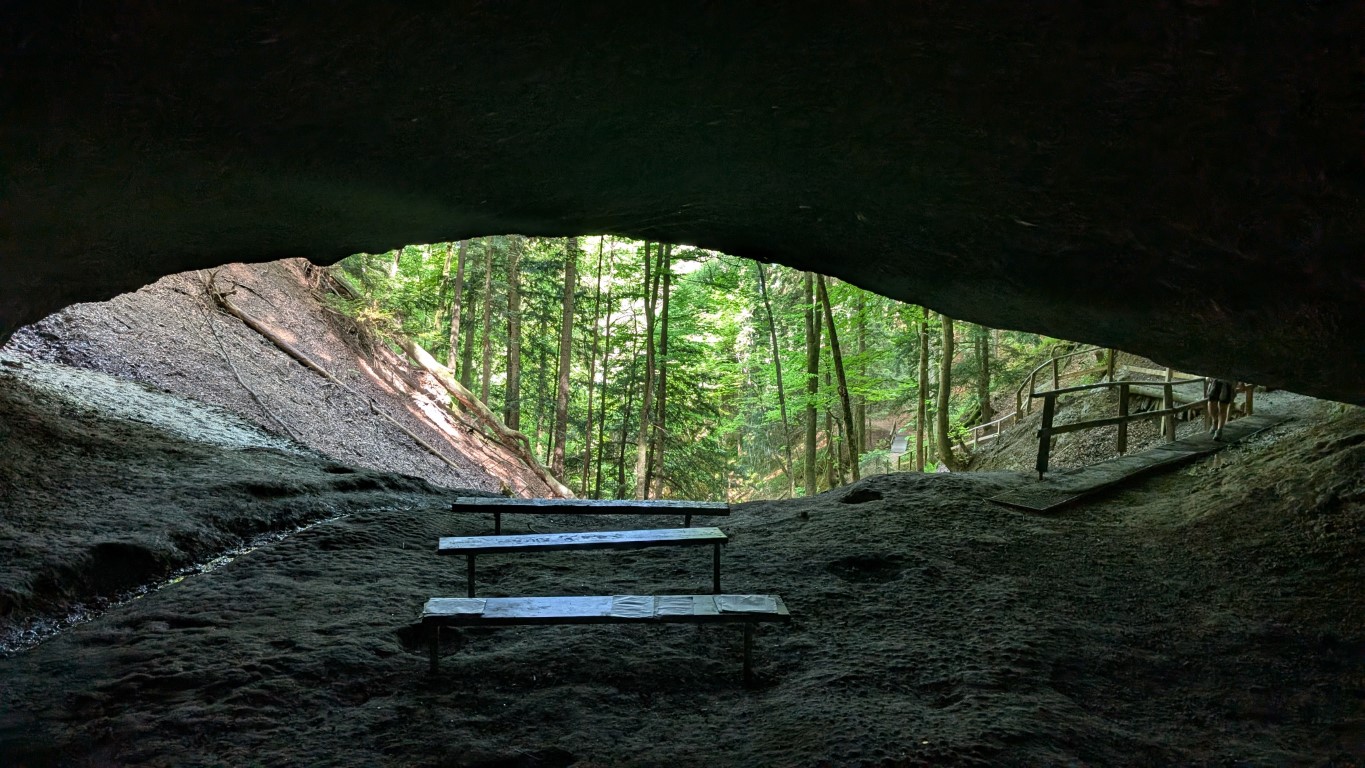Hidden beneath the protective blanket of a horizontal layer of conglomerate, deep in the wooded slope of the Allmen near Bäretswil, lies a silent witness to history – the Anabaptist Cave. Those who take the winding path through the enchanting forest will, after just under a quarter of an hour's hike, reach a place that is more than just a cave. It is a refuge. A stone shelter. A sacred breath of past resistance.
Here, at 910 meters above sea level, enveloped by the gentle murmur of a waterfall, a cave of surprising expanse opens beneath moss-covered rock ledges: its stone embrace measures 40 meters wide, it extends 30 meters into the depths of the mountain, and its ceilings rise up to four meters. In its shelter, even the echo seems to whisper more quietly – reverently, as if it doesn't want to disturb the memories of the centuries.
A refuge for the persecuted
In the 16th century, when the winds of the Reformation blew through Zurich and reorganized religious orders, not everyone was willing to bow to this storm without a fight. The Anabaptists, radical in their belief in the baptism of mature adults, quickly became the target of the authorities. In 1526, the Zurich Council decreed death for all who did not recant.
And so they fled. Into forests. Into mountains. Into caves.
The Anabaptist Cave became a hiding place, a shelter from persecution, a church without a tower but with a stone roof. Whether Felix Manz, co-founder of the Zurich Anabaptist movement, also hid here is unknown—but legend breathes a certain presence into his name among the rock walls.
Ghost in the Grotto
Today, the cave contains benches, and a fireplace invites visitors to linger. School classes and youth groups spend the night here, where religious refugees once prayed trembling. The dry earth beneath their feet still bears traces of the past: When niches containing cutlery and painted tiles were discovered in 1830, it was believed to be evidence of the Anabaptist era. Later, it emerged that a summer tavern operated here in the 19th century. And yet, the idea persists—like shadows in torchlight—that the cave was once a spiritual center, hidden in the thicket.
Symbol of the Oberland soul
Georg Schmid, a religious historian and a keen observer of Zurich Oberland spirituality, calls the Anabaptist Cave a monument of resistance—not only against repression, but also against intellectual conformity. The people here, he argues, are closer to heaven than to the city, their religion more personal, more immediate, more idiosyncratic. The cave, as a symbolic space, thus becomes a metaphor for an inner landscape: rugged yet courageous. Wild yet wise.
It is a mysticism of earth and faith, of solitude and election. A spirituality that leads through valleys of humiliation to exaltation, in which the infinite is reflected in the smallest detail: a drop of water that shapes the rock over millennia. A prayer that never fades away among the mosses and stones.
Tenses: Ice and water
The cave itself is older than any human word, formed by the interplay of meltwater and stone. During the last Ice Age, meltwater from the Linth glacier penetrated the depths of the Allmen plain, burrowing through crevices and leaving behind a marvel of erosion. The Holenstein Gorge below the cave, with its V-shaped cut, speaks of a primeval power that today is barely a trickle. And yet: you can still feel it, the primal power, when you stand before the rock gate and hear the gentle rippling – like the whisper of time.
Those who visit the Anabaptist Cave enter more than just a geological cavity. They enter a memory. A place where stone and spirit meet. Where the eternal is concealed in a fold of the mountain.
Light Gallery cannot find your image path: images/unterwegs/202505taeufehoehle!


